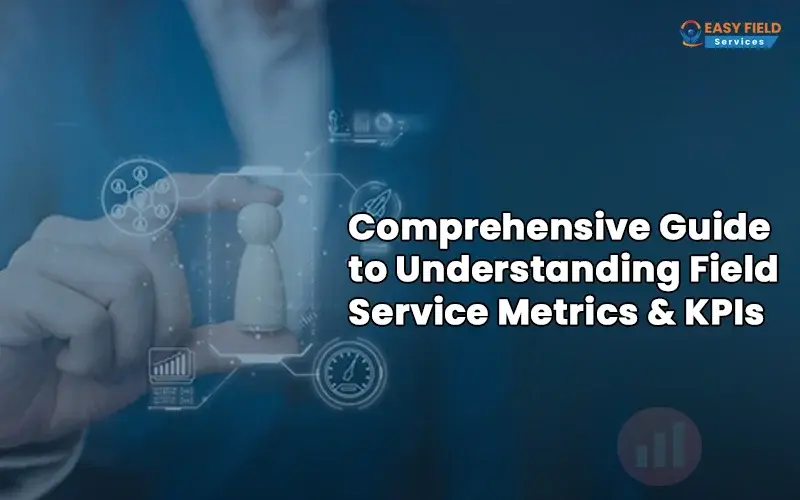The Ultimate Guide to Field Work Order Allocation & Prioritization
Overview
- Efficient Work Order Management
- Importance of Field Work Order Allocation and Prioritization
- Reduce Manual Intervention With Automating Work Order Processes
- Get Real-Time Visibility with Field Work Order Tracking Software
- Enhance Overall Productivity With Advanced Work Order Management
- Strategies for Optimal Work Order Allocation
- Assess Current Workflow
- Choose the Right Software
- Employee Training and Adoption
- Work Order Prioritization Strategies
- Maintain Open Communication
- Due Date Consideration
- Emergency Level Prioritization
Efficiency is a crucial factor in the success of field service management. To streamline operations, service businesses are increasingly adopting advanced solutions like field service work order management software. This guide explores fieldwork allocation and prioritization, offering a roadmap for effective orders. Further, it includes a method for enhanced effectiveness and adheres to best practices. Moreover, by integrating these methods you can enhance the effectiveness of your field service work order allocation and prioritization process and give your clients high-quality service by adhering to the best practices described in this article.
Efficient Work Order Management
Efficient work order management lies at the core of streamlined field service operations. By implementing a field service work order management software in your service business you can ensure tasks are assigned intelligently and in real-time. The systems consider a combination of factors such as workflow, software selection, skillset, due date, and task prioritization to optimize your field work orders.
Simultaneously, by leveraging a field work order tracking system, your service businesses can centralize the work order management process. This allows you to create, assign, dispatch, and track work orders electronically, all while using field service work order management software and ensuring efficient task allocation. Moving forward, subsequent steps introduce the importance of work allocation and prioritization, followed by strategies for optimal order management.
Importance of Field Work Order Allocation and Prioritization
Reduce Manual Intervention With Automating Work Order Processes
Field service work order automation is impacting traditional field service processes. Work order software streamlines processes from task creation to completion, providing real-time notifications to technicians for the latest information. Automating the work allocation process not only saves time but also improves accuracy and results in faster efficient service delivery.
In prioritization, automation plays a vital role in evaluating and ranking tasks based on predefined criteria. This feature ensures a standardized and consistent approach to prioritizing fieldwork allocation orders, reducing the need for manual assessment. Automated prioritization enables proactive strategies in addressing critical tasks, enhancing overall operational efficiency by streamlining allocation and optimizing resources.
Get Real-Time Visibility with Field Work Order Tracking Software
Real-time visibility into the location and activities of field workers is crucial for efficient task allocation. Fieldwork tracking software provides this visibility, optimizing work order assignment by considering factors such as geographical proximity, skills, and workload. This minimizes travel time and improves field service response for efficient service operations.
While in work order prioritization, visibility into the real-time location of field technicians is crucial. By monitoring their locations, tasks can be prioritized based on urgency and proximity, minimizing delays and improving response times. Real-time tracking facilitates a dynamic approach to prioritize field service work orders efficiently.
Enhance Overall Productivity With Advanced Work Order Management
A complete field service work order scheduling software plays a significant role in enhancing overall productivity. Through advanced work order management software, your service business can systematically assign tasks, ensuring that skilled technicians are deployed where their expertise is most needed. This results in reduced downtime and maximize workforce efficiency, which are key goals for any service business.
When it comes to prioritization, advanced work order management software provides significant insights into key performance metrics, such as response times and completion rates with guided prioritization strategies. This data-driven approach is valuable for field service businesses, enhancing overall productivity by identifying improvement areas and optimizing resource allocation.
Strategies for Optimal Work Order Allocation
To achieve optimal work order allocation, organizations should adopt a proactive approach. Regularly reviewing and updating allocation processes is essential. Scheduling, dispatching, and work order management become more efficient when supported by end-to-end scheduling work order management software. By analyzing historical data and performance metrics, you can identify patterns and trends in work order allocation.
This information can be used to develop intelligent algorithms that help prioritize tasks based on factors such as workflow, software selection, and technician skill level. Work order management applications can facilitate this process by providing customizable workflows and real-time analytics, enabling your service businesses to make data-driven decisions and allocate resources effectively. Let’s explore these transformative strategies to make informed decisions for your field service operations.
Assess Current Workflow
While initiating a step towards field work order implementation, as a field service business owner, you need to meticulously assess your current workflow. This initial step involves a thorough examination aimed at uncovering existing challenges that may hinder optimal field work order management. By delving into the intricacies of day-to-day service operations, organizations gain valuable insights into areas requiring improvement.
Additionally, the process includes the meticulous collection of data related to past order allocation. This historical perspective serves as a foundation, enabling service providers to make informed decisions during the transition to a more streamlined and efficient workflow.
Choose the Right Software
The selection of suitable software stands as a vital decision for optimized field work order management. This segment provides a detailed exploration of the research process, guiding businesses through the intricacies of comparing available field work order software.
The attention goes beyond simply examining a feature, it includes considerations of scalability and the importance of user-friendly interfaces. These factors are crucial to ensure a seamless integration of the chosen software into existing operations, minimizing disruptions and facilitating a smooth transition toward enhanced efficiency.
Employee Training and Adoption
Acknowledging that no software implementation is truly complete without proper training and user adoption, ensure that all your field technicians are equipped with a comprehensive training program. Beyond the technical aspects, businesses are encouraged to foster a positive attitude among team members towards adopting the new system.
The importance of training your field employees not just imparting technical skills but also instilling a sense of ownership and enthusiasm among employees. By investing in the human element of the transition, you can pave the way for the successful adoption of the new system in your field service organization to maximize its potential impact on overall task prioritization efficiency and productivity.
Work Order Prioritization Strategies
In the quest for optimal efficiency, prioritizing work orders requires precision. Implementing a priority matrix allows businesses to rank work orders based on technician collaboration, due date, and user prioritization. Assigning tasks based on technicians’ locations minimizes travel time, ensures quicker responses, enhances efficiency, and reduces operational costs.
A significant field service work order software system can assist in prioritizing your business tasks by providing automated alerts and reminders based on predefined criteria. By establishing a standardized approach to prioritization, you can ensure that critical tasks are addressed promptly while balancing workload allocation. With the below approach field service businesses can structure their work orders well and effectively.
Maintain Open Communication
Foster an environment of open communication within the field service team. Encourage team members to share insights, concerns, and updates related to their workload and ongoing tasks. This helps in maintaining transparency and ensures everyone is on the same page. Implement communication tools, such as field team communication software to facilitate real-time communication.
These tools enable quick exchanges of information, allowing team members to stay informed about any changes or developments. Establish feedback channels where team members can provide input on the work order prioritization process. This creates a collaborative environment where everyone’s perspective is considered.
Due Date Consideration
Consider scheduled due dates of work orders when prioritizing tasks as time management plays a critical role. This strategy ensures completing tasks within the stipulated time, meeting client expectations, and preventing unnecessary delays. Proactively considering due dates contributes to overall client satisfaction.
To streamline due date consideration, integrate a scheduling work order management software that provides a visual representation of task timelines. This tool enables dispatchers and technicians to easily identify and prioritize tasks based on their due dates, facilitating efficient time management
Emergency Level Prioritization
In task prioritization, let urgency guide the categorization of work orders. Establish a system that categorizes work orders based on their level of urgency. Prioritize tasks requiring immediate attention, ensuring that critical and emergency issues are addressed promptly. This proactive approach not only prevents further damage in unexpected demand but also showcases your commitment to swift problem resolution. To enhance emergency-level prioritization, consider implementing automated alert systems. These systems can notify relevant personnel instantly when a critical task is logged, expediting response times and minimizing potential disruptions.
In a nutshell, the seamless integration of advanced technology and strategic decision-making enables businesses to master field service operations. Automated field service management, with end-to-end field job dispatch software for work order allocation and prioritization has become not just a trend but a strategic necessity for staying competitive in a dynamic service landscape. By utilizing the features of automated field service management, businesses can witness better efficiency, optimize their operations, and deliver exceptional client experiences.
However, most field service businesses often lack an idea about how to initiate their fieldwork order allocation and prioritization. This is where fully equipped field service software proves handy. With that, you can strategically allocate resources, prioritize tasks based on data and collaboration between technology and skilled professionals, and utilize their full potential to achieve sustainable growth in the field service industry. Streamline the way you handle work orders, optimize your resources, and ensure every project propels you toward success. Take control of your service workflow, enhance collaboration, and establish the foundation for sustained success. Gear up for a groundbreaking approach to assigning and prioritizing field work orders.





